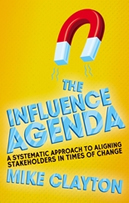
A conversation with...
 | Mike Clayton, author of The Influence Agenda, sets out what it means to influence and engage with stakeholders, and why they are so crucial in times of change. |  |
Your book The Influence Agenda sets out a practical and systematic framework for engaging, influencing and enlisting the support of stakeholders. Why have you decided to write this book and why should project leaders and managers take note?
There are two reasons why I have wanted to write The Influence Agenda for a long time (I first set out the basic structure for it in my notes back in April 2011).
The first is a pragmatic one: there is very little available for project managers to read about stakeholder engagement. All project managers know that it is a vital aspect of our work - whether we are building new infrastructure or integrating complex cultural change within our organisations. Yet despite there being a huge market in project management books and in some of the specialisms, like risk management, there is a real paucity of books on managing the stakeholder engagement part of a project or change initiative. On a more personal note, this book completes a kind of ‘set’ for me: How to Manage a Great Project is my introductory book on the basics of project management, and Brilliant Project Leader is about the leadership aspects of the role. In Risk Happens! I focus on the management of risk, so The Influence Agenda, with its focus on stakeholders was a natural book to want to write.
The second and more important reason for wanting to write The Influence Agenda is simple: it is time that stakeholder engagement became recognized as an important discipline in its own right. I hope that the new book will make a contribution to organisations and professionals taking the subject more seriously as a body of knowledge and as a core capability. This is the main reason why I wanted to incorporate a stakeholder engagement maturity model into the book; to give organisations a nudge towards embedding the skills and resources into their day-to-day practices.
One of the reviews I am most proud of, recognizes this aspect of my ambition. Richard Barton, a partner at Atos Consulting, said: “Mike has provided a comprehensive guide to stakeholder management that should help elevate the status of stakeholder management to the same level as risk management in the mind of a Project or Change Manager.”
Can you briefly define what a stakeholder is, and why they are so crucial in times of change?
A stakeholder is anyone who has any interest in what you are doing. Some, of course will have more interest in - and influence over - your activities than others. However, all have their own agenda and it is they, ultimately, who will determine the success, or not, of your endeavours.
In times of change, stakeholders need to respond and adapt to the changes. If you fail to properly engage them; you are setting yourself up for more resistance than is necessary. This can result in multiple points of failure. On the other hand, when you fully engage with stakeholders and bring in their ideas and enthusiasms, you can harness so much ore energy and insight than your team can provide on its own.
What are the most common forms of resistance you have encountered when dealing with change management, and how does your book help tackle these?
Over the last fifteen years, I have been collating and trying to understand resistance to change. In around 2003, I developed my Onion Model of resistance, which helps us to recognize resistance, by placing it into one of six fundamental types: the layers of the onion. Examples include not understanding why change is necessary and not liking the change that is happening. Perhaps readers would like to watch a quick video summary.
I have given over a whole chapter of The Influence Agenda to the subject of resistance, linking it to some of the ideas earlier in the book, and applying The Onion Model to it. The chapter is called “A dozen reasons why you’re wrong” because resistance only starts hen people think rationally about the changes. At first, our response is emotional, and there is nothing you can do about this, except to respect the emotions and let them dissipate.
But once they do, we become rational and start to spot all of the reasons why the change is wrong. And the reality is, that some of these reasons will be wholly appropriate, because big, complex organisations have to balance so many factors in designing change. In doing so, they are also balancing the needs of many different stakeholders, so it is no surprise that some will be losers, and will find good reasons to resist. This is why open, respectful engagement is so important.
How has your own professional experience prepared you to write this book?
I spent twelve years delivering projects for clients in all sectors of the UK economy, from small local authorities to large multi-national corporations. As a Senior Manager with international consulting firm Deloitte, I was also responsible for thought leadership and developing new methodology. Project management and model-building are in my DNA.
I also want to acknowledge the importance of a friend and colleague (Judith Wilks, to whom the book is dedicated) in really focusing me on the stakeholder engagement aspects of project management, when we led complementary components of a large project. This started me on the track of trying to understand resistance and motivation, and to catalogue the tools that we, as working project managers, can use day-to-day. This is especially important for those of us, like myself, who lack Judith’s innate insights and understanding, and so need tools to help us.
I hope this book provides a comprehensive toolkit, and was pleased when Stuart Crowther, Managing Director of Specific People, said: “It guides the reader through the simple principles to a complete set of tools and checklists that teach you how to identify, develop strategies, and genuinely engage with stakeholders.”
Can you explain a little about the ‘Charter for Ethical Stakeholder Engagement’?
Some of the tools available to us as influencers are astonishingly powerful. There is a chapter in The Influence Agenda about the growing science of Behavioural economics - or Hidden Power, as I call it. These tools work on our psychology to influence the choices we make and, without doubt, could be employed unscrupulously by some. It seems no coincidence that most research and investment in trying the tools out is coming from the advertising and political domains.
So it occurred to me that, if we are to use such powerful tools, we must do so responsibly. For that reason, I figured that stakeholder engagement managers need a kind of code of conduct. Many professions have charters and codes of conduct, so why not ours. So I developed my own Charter for Ethical Stakeholder Engagement and invite anyone to sign up to it. You can do so on The Influence Agenda website.
Please share your favourite quote or piece of wisdom from the book and why you think it will resonate with professional readers.
In preparing the book, I interviewed a number of former colleagues, who are highly active in delivering change, managing projects, and critically, in engaging actively with their stakeholders. I think it is their case studies and wisdom that really bring the book to life.
Since many professional readers will not send their working lives in project environments, I have selected one of the “Wise words from real practitioners” that is applicable in all spheres of life.
“People are wired differently. Your task is to try to figure out what sort of person they are and what kinds of message will resonate with them so that you can connect with them on their own wavelength. This also allows you to be more targeted and specific in what you communicate.”